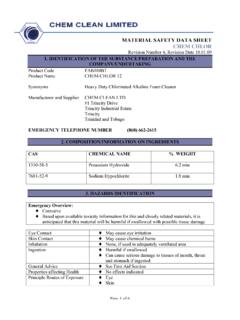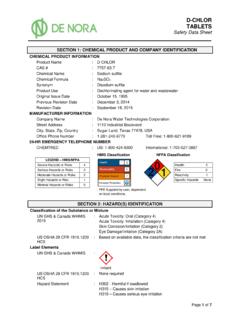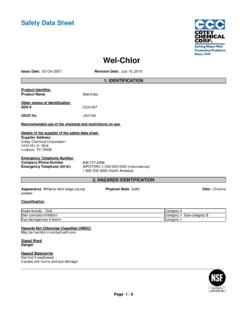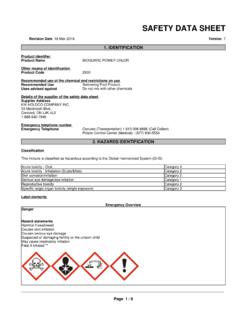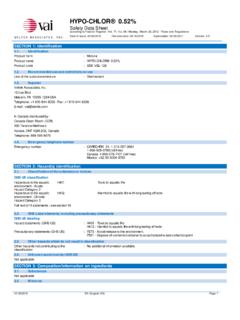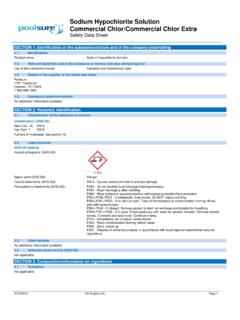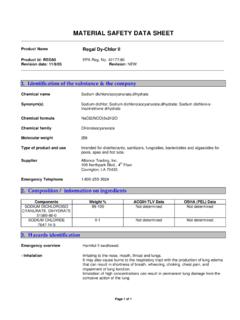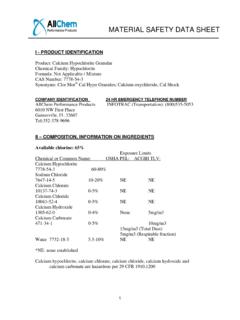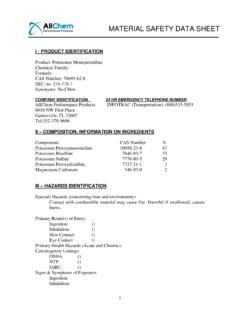Transcription of SAFETY DATA SHEET - Jet-Lube
1 Page 1 / 7 SAFETY data SHEET Issuing Date 18-Jun-2015 Revision Date 6-Mar-2017 Revision Number 1 1. IDENTIFICATION OF THE SUBSTANCE/PREPARATION AND THE COMPANY/UNDERTAKING GHS product identifier product Name Jet-Lube CHLOR-OUST Other means of identification Synonyms CHLOR-OUST Recommended use of the chemical and restrictions on use Recommended Use Water treatment chemical Uses advised against No information available Supplier's details Manufacturer Address Jet-Lube , LLC 930 Whitmore Dr. Rockwall, Texas 75087 TEL: 972-771-1000 Toll Free: 1-800-669-6318 Emergency telephone number Emergency Telephone CHEMTREC: +1-703-527-3887 (INTERNATIONAL) Number 1-800-424-9300 (NORTH AMERICA) 2.
2 HAZARDS IDENTIFICATION Classification This chemical is considered hazardous according to the OSHA Hazard Communication Standard 2012 (29 CFR ) Acute Oral Toxicity Category 4 Acute Inhalation Toxicity - Dusts and Mists Category 4 Serious Eye Damage/Eye Irritation Category 2 Specific Target Organ Systemic Toxicity (Single Exposure) Category 3 GHS Label elements, including precautionary statements Emergency Overview Signal Word Hazard Statements Harmful if swallowed Harmful if inhaled Causes serious eye irritation May cause respiratory irritation Warning Page 2 / 7 Revision Date 6-Mar-2017 Jet-Lube CHLOR-OUST Appearance Colorless. White. Physical State Solid Odor Odorless Precautionary Statements Prevention Avoid breathing dust/fume/gas/mist/vapors/spray.
3 Use only outdoors or in a well-ventilated area. Wash face, hands and any exposed skin thoroughly after handling. Do not eat, drink or smoke when using this product . Wear eye/face protection. General Advice None Eyes IF IN EYES: Rinse cautiously with water for several minutes. Remove contact lenses, if present and easy to do. Continue rinsing. If eye irritation persists: Get medical advice/attention. Inhalation IF INHALED: Remove victim to fresh air and keep at rest in a position comfortable for breathing. Call a POISON CENTER or doctor/physician if you feel unwell. Ingestion IF SWALLOWED: Call a POISON CENTER or doctor/physician if you feel unwell.
4 Rinse mouth. Storage Store in a well-ventilated place. Keep container tightly closed. Store locked up. Disposal Dispose of contents/container to an approved waste disposal plant. Hazard Not Otherwise Classified (HNOC) Not applicable Other information Very toxic to aquatic life with long lasting effects 0% of the mixture consists of ingredient(s) of unknown toxicity. 3. COMPOSITION/ information ON INGREDIENTS Synonyms STERILENE Chemical Name CAS-No Weight % Trade secret Sodium thiosulfate pentahydrate 10102-17-7 90-100 * *The exact percentage (concentration) of composition has been withheld as a trade secret. Page 3 / 7 Revision Date 6-Mar-2017 Jet-Lube CHLOR-OUST 4.
5 FIRST AID MEASURES Description of necessary first-aid measures General Advice Show this SAFETY data SHEET to the doctor in attendance. Eye Contact Check for and remove any contact lenses. In case of contact, immediately flush eyes with plenty of water for at least 15 minutes. Cold water may be used. Get medical attention if irritation occurs. Skin Contact Wash with soap and water. Cover the irritated skin with an emollient. Get medical attention if irritation develops. Cold water may be used. Inhalation If inhaled, remove to fresh air. If not breathing, give artificial respiration. If breathing is difficult, give oxygen. Get medical attention. Ingestion Do NOT induce vomiting unless directed to do so by medical personnel.
6 Never give anything by mouth to an unconscious person. If large quantities of this material are swallowed, call a physician immediately. Loosen tight clothing such as a collar, tie, belt or waistband. Protection of First-aiders Use personal protective equipment. Most important symptoms/effects, acute and delayed Most Important Symptoms/Effects Eye irritation/reactions. Indication of immediate medical attention and special treatment needed, if necessary Notes to Physician Treat symptomatically. 5. FIRE-FIGHTING MEASURES Suitable Extinguishing Media Use extinguishing measures that are appropriate to local circumstances and the surrounding environment. Unsuitable Extinguishing Media No information available.
7 Specific Hazards Arising from the Chemical No information available. Explosion data Sensitivity to Mechanical Impact None. Sensitivity to Static Discharge None. Protective Equipment and Precautions for Firefighters As in any fire, wear self-contained breathing apparatus pressure-demand, MSHA/NIOSH (approved or equivalent) and full protective gear. 6. ACCIDENTAL RELEASE MEASURES Personal precautions, protective equipment and emergency procedures Personal Precautions Avoid dust formation. Ensure adequate ventilation. Avoid contact with skin, eyes and clothing. Use personal protective equipment. Avoid inhalation of dust. Environmental Precautions Environmental Precautions Avoid release to the environment.
8 Prevent further leakage or spillage if safe to do so. Prevent product from entering drains. See Section 12 for additional Ecological information . Methods and materials for containment and cleaning up Methods for Containment Prevent further leakage or spillage if safe to do so. Page 4 / 7 Revision Date 6-Mar-2017 Jet-Lube CHLOR-OUST Methods for Cleaning Up Small Spill - Use appropriate tools to put the spilled solid in a convenient waste disposal container. Finish cleaning by spreading water on the contaminated surface and dispose of according to local and regional authority requirements. Large Spill - Use a shovel to put the material into a convenient waste disposal container.
9 Finish cleaning by spreading water on the contaminated surface and allow to evacuate through the sanitary system. Precautions for safe handling 7. HANDLING AND STORAGE Handling Do not breathe dust. Wear suitable protective clothing. In case of insufficient ventilation, wear suitable respiratory equipment. If you feel unwell, seek medical attention and show the label when possible. Keep away from incompatibles such as oxidizing agents, acids, alkalis. Conditions for safe storage, including any incompatibilities Storage Hygroscopic. Keep container tightly closed. Keep container in a cool, well-ventilated area. Incompatible Products Oxidizing agents.
10 8. EXPOSURE CONTROLS / PERSONAL PROTECTION Control parameters Exposure Guidelines This product does not contain any hazardous materials with occupational exposure limits established by the region specific regulatory bodies. Appropriate engineering controls Engineering Measures Showers Eyewash stations Ventilation systems Individual protection measures, such as personal protective equipment Eye/Face Protection SAFETY glasses with side-shields. Skin and Body Protection Protective gloves. Impervious clothing. Respiratory Protection No protective equipment is needed under normal use conditions. If exposure limits are exceeded or irritation is experienced, NIOSH/MSHA approved respiratory protection should be worn.
